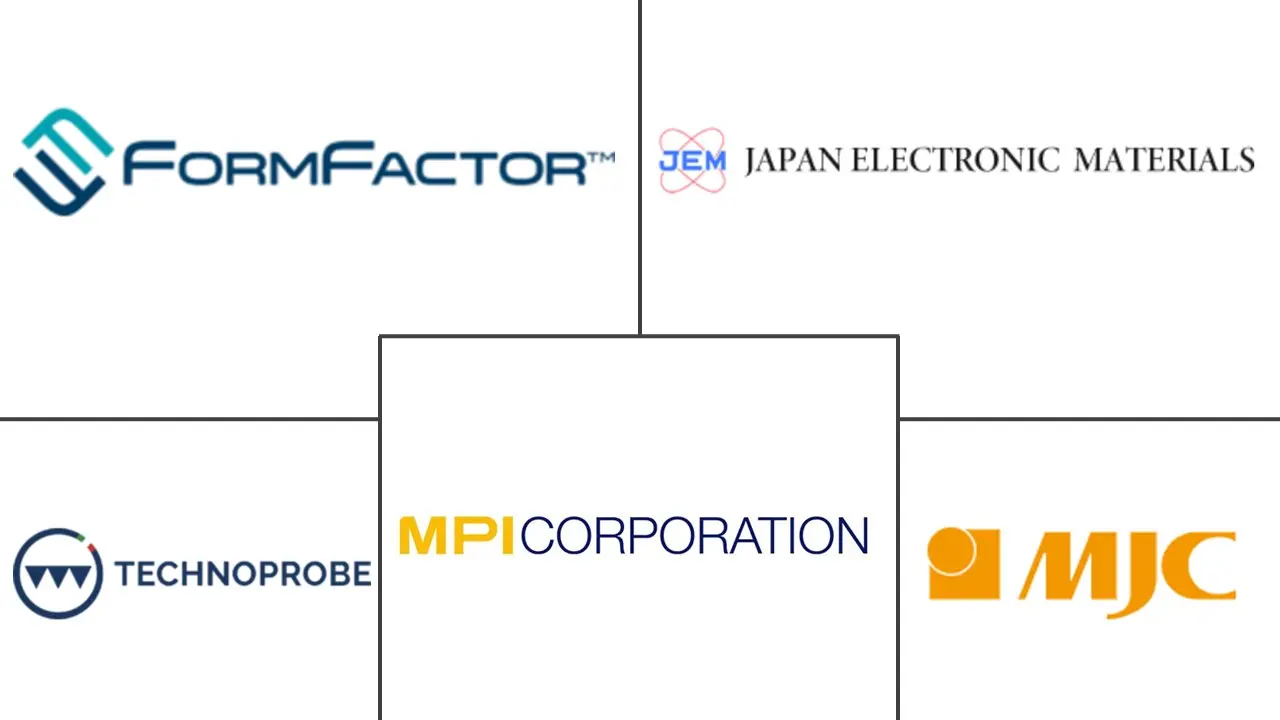Probe Card Market Size and Share
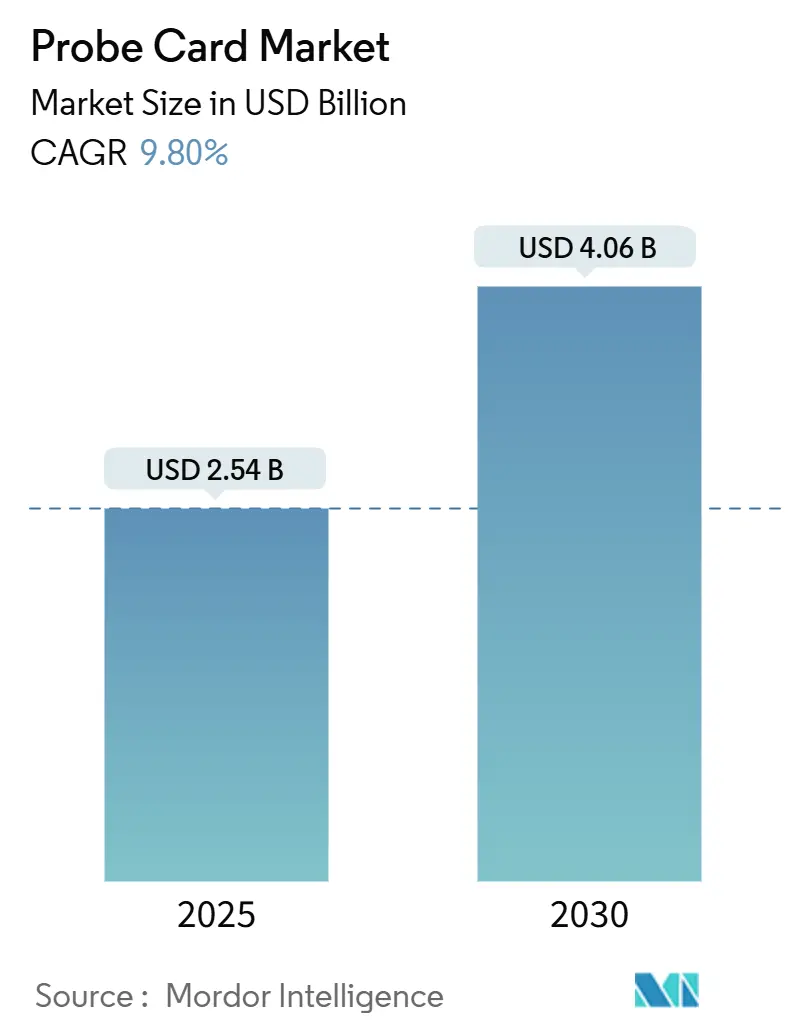
Probe Card Market Analysis by Mordor Intelligence
The Probe Card Market size is estimated at USD 2.54 billion in 2025, and is expected to reach USD 4.06 billion by 2030, at a CAGR of 9.80% during the forecast period (2025-2030).
- Increased semiconductor production and ongoing investments by the government and key vendors in semiconductor foundries are driving the market's growth. Additionally, advancements in packaging technology are fueling the demand for efficient probe cards used in semiconductor chip testing. MEMS technology is gaining prominence in the probe card market due to its testing accuracy and benefits. The rising adoption of semiconductor chips across various sectors, such as automotive, communication, consumer electronics, and healthcare, further propels the market's expansion.
- As investments in the global chip manufacturing industry surge, the global probe card market is poised to seize numerous opportunities. The increasing demand for semiconductors, driven by technological advancements such as artificial intelligence, 5G, and IoT, is expected to further amplify the need for efficient chip testing solutions.
- Additionally, technological innovations are set to bolster this market's growth, with vendors increasingly focusing on crafting advanced solutions tailored to the dynamic needs of the chip testing and verification sector. These innovations include the development of probe cards capable of handling higher frequencies, smaller pitches, and more complex architectures, ensuring compatibility with next-generation semiconductor devices.
- However, the high costs associated with probe cards pose a challenge to this growth. Rising raw material prices are inflating the production costs of probe cards, thereby hindering the market's expansion.
- The geopolitical tensions could disrupt semiconductor production in regions like Europe and the Middle East. In light of this, companies are reevaluating their business continuity strategies, seeking alternative sources for crucial materials like neon and palladium, and adopting forward pricing tactics to counteract price volatility. Such moves could influence DRAM production and subsequently dampen the growth of the probe card market.
Global Probe Card Market Trends and Insights
DRAM to be the Fastest Growing Application Segment
- Probe cards are vital in pioneering research and development of emerging DRAM technologies. With rising demands for enhanced performance and memory capacity, both researchers and manufacturers are innovating new DRAM architectures. By connecting with experimental chips, probe cards allow researchers to assess and refine the electrical characteristics of these new designs, optimizing their performance for the future.
- With the rising demand for enhanced memory capacity and quicker data access, the DRAM industry's probe card market has seen notable expansion. As DRAM technology evolves, moving towards high-density memory modules and smaller process nodes, the need for sophisticated probe cards has become paramount.
- As DRAM chips evolve, they demand probe cards that can accommodate higher pin counts, tighter pad pitches, and denser contacts. In response, probe card manufacturers are innovating relentlessly, propelling the market's growth. Additionally, the surge in smartphones, tablets, and portable devices is set to fuel this market expansion further.
- As cloud services and storage solutions gain traction, the appetite for high-performance servers and memory-intensive applications has skyrocketed. Data centers, needing vast amounts of DRAM for intricate computations and data storage, are seeing a surge in demand. With businesses leaning toward cloud computing, this DRAM demand is poised to keep climbing.
- Memory-intensive applications like artificial intelligence, big data analytics, and cloud computing are driving a surge in demand for premium DRAM chips. During testing and validation, probe cards are crucial for ensuring the quality and reliability of these chips. Thus, as the thirst for top-tier DRAM grows, so does the need for efficient and dependable probe cards.
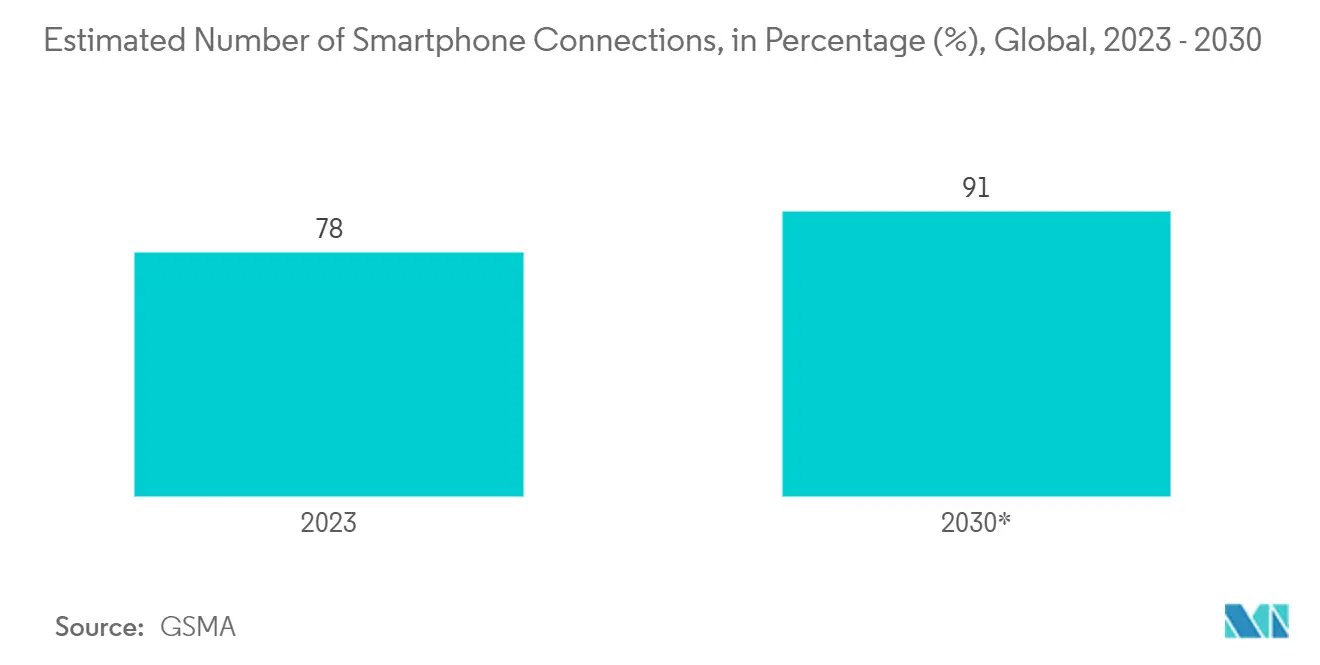
Asia Pacific to Register Major Growth
- Asia-Pacific is anticipated to remain among the prominent contributors to the market's growth, considering the changing dynamics of various regional industries. The region has well-known semiconductor manufacturers, major suppliers of semiconductor materials, advanced equipment, and specialized semiconductors, primarily in China and Japan.
- South Korea's competitive advantage in the global high-bandwidth memory (HBM) and dynamic random-access memory (DRAM) markets is another driving force behind the probe card market. The integration of semiconductors into automotive electronics for safety, automation, electrification, and security purposes also contributes to the growth of the probe card market in the region.
- The region is investing heavily in its automotive industry, owing to a newer and more sustainable future. This creates a high demand for IGBT semiconductors, AC-DC converters, automotive ICs, etc., thus propelling the demand for probe cards in the region. The Chinese automotive and mobility industry is globally renowned for its strong performance in the domestic market and promising prospects. The Chinese Ministry of Industry and Information Technology forecasts that the country's vehicle production will hit 35 million by 2025, solidifying its position as the top car manufacturer worldwide.
- Furthermore, the growth of the studied market in the Asia Pacific region is also supported by the expanding size of the consumer electronics industry. Countries in the Asia Pacific region have witnessed a notable surge in the adoption of digital technologies, which is creating the demand for consumer electronics and computing devices wherein semiconductor chips are widely used. Thus, it is creating a favorable ecosystem for the studied market’s growth.
- Additionally, the region's expanding semiconductor manufacturing facilities are spurring demand for probe cards. Estimates from the Semiconductor Industry Association (SIA) project the Asia-Pacific region will command a significant share of global wafer fabrication capacity by 2032, with China leading at approximately 21%. This dominance underscores China's strategic investments in semiconductor technology, which are aimed at reducing reliance on imports and enhancing its position in the global semiconductor supply chain.
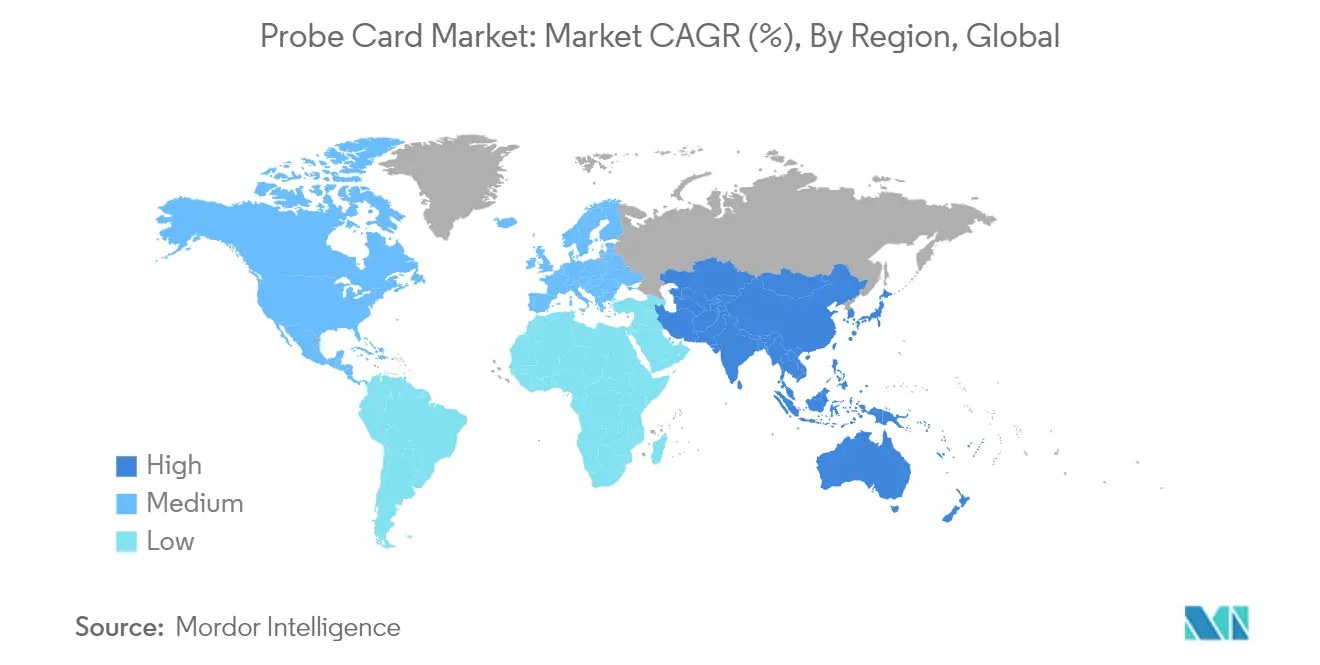
Competitive Landscape
The probe card market is consolidated, with several leading players, such as FormFactor Ltd, Technoprobe Inc., Microfriend Inc., MICRONICS JAPAN CO. LTD, MPI Corporation, SV Probe, Japan Electronic Materials Corporation, and Precision Test Tech. Co. Ltd, Nidec Corporation, Korea Instruments Co. Ltd., WILL Technology Co. Ltd., STAr Technologies, Inc., and others, present. The market players strive to innovate advanced and comprehensive products to cater to consumers' complex and evolving demands.
In a bid to bolster their foothold in the consolidated market landscape, vendors are increasingly resorting to strategic maneuvers, notably mergers and acquisitions. For instance, in May 2024, Nidec Advance Technology Corporation, renowned for its high-performance probe cards and MEMS probes via its subsidiary Nidec SV Probe, inked a collaboration pact with Synergie Cad Group. The latter, hailing from Europe, specializes in designing and manufacturing Printed Circuit Board Assembly (PCBA) probe cards and turnkey test solutions. Under the terms of their strategic partnership, both companies will collaboratively promote, sell, and support each other's offerings across specified territories.
Probe Card Industry Leaders
-
Formfactor Inc.
-
Technoprobe S.P.A.
-
Micronics Japan Co. Ltd
-
Japan Electronic Materials Corporation
-
MPI Corporation
- *Disclaimer: Major Players sorted in no particular order
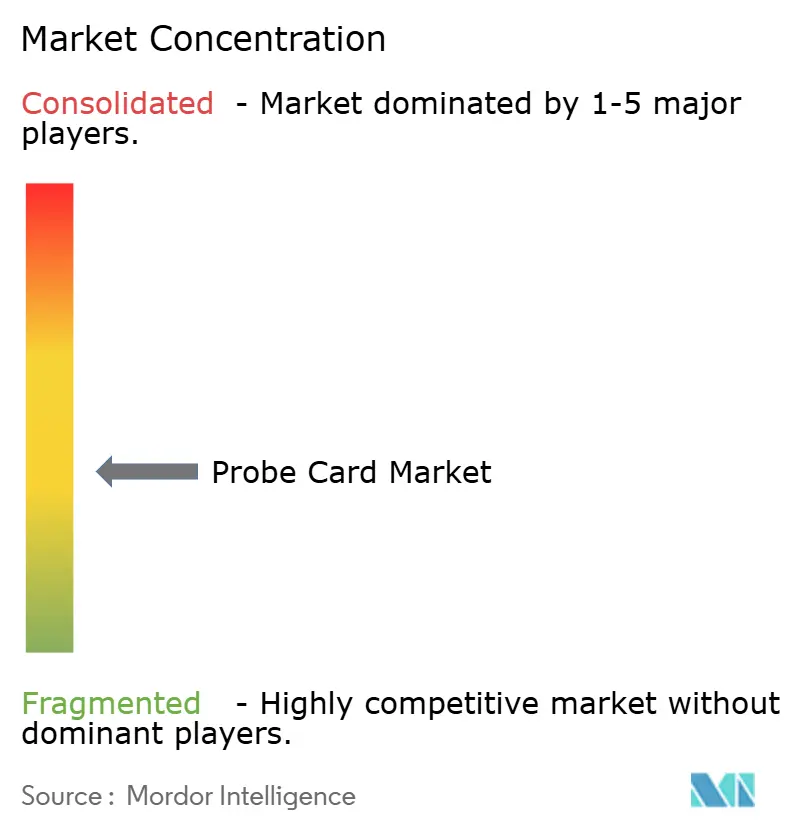
Recent Industry Developments
- May 2024: FormFactor has once again earned accolades in TechInsights' customer satisfaction survey, underscoring its prominence in the semiconductor industry. In this survey, semiconductor manufacturers globally assess their suppliers on criteria such as customer service, product performance, and overall performance. For an impressive eleven consecutive years, FormFactor has been recognized as a leading supplier of Test Subsystems, particularly in the realm of probe card manufacturing.
- May 2024: MJC Europe GmbH, a subsidiary of Micronics Japan Co., Ltd., moved to a new office in January 2024. This relocation aimed to enhance sales prospects for probe cards and test sockets designed for logic chips, with a particular emphasis on the automotive sector in Europe. The company's new premises in Munich are strategically positioned within key hubs of the semiconductor industry in Europe.
Global Probe Card Market Report Scope
Probe cards are advanced devices for testing the functioning of chips during their construction process. The market is defined by the revenue accrued from the offering of probe cards by major market players.
The probe card market is segmented by technology (MEMS, vertical, cantilever, specialty, other technologies), by application (DRAM, flash, foundry and logic, parametric, other applications), by type (standard probe card, advanced probe card), by geography (North America, Europe, Asia Pacific, rest of the World). The market sizes and forecasts are provided in terms of value (USD) for all the above segments.
| MEMS |
| Vertical |
| Cantilever |
| Speciality |
| Other Technologies |
| DRAM |
| Flash |
| Foundry and Logic |
| Parametric |
| Other Applications |
| Standard Probe Card |
| Advanced Probe Card |
| North America |
| Europe |
| Asia |
| Australia and New Zealand |
| Latin America |
| Middle East and Africa |
| By Technology | MEMS |
| Vertical | |
| Cantilever | |
| Speciality | |
| Other Technologies | |
| By Application | DRAM |
| Flash | |
| Foundry and Logic | |
| Parametric | |
| Other Applications | |
| By Type | Standard Probe Card |
| Advanced Probe Card | |
| By Geography*** | North America |
| Europe | |
| Asia | |
| Australia and New Zealand | |
| Latin America | |
| Middle East and Africa |
Key Questions Answered in the Report
How big is the Probe Card Market?
The Probe Card Market size is expected to reach USD 2.54 billion in 2025 and grow at a CAGR of 9.80% to reach USD 4.06 billion by 2030.
What is the current Probe Card Market size?
In 2025, the Probe Card Market size is expected to reach USD 2.54 billion.
Who are the key players in Probe Card Market?
Formfactor Inc., Technoprobe S.P.A., Micronics Japan Co. Ltd, Japan Electronic Materials Corporation and MPI Corporation are the major companies operating in the Probe Card Market.
Which is the fastest growing region in Probe Card Market?
Asia Pacific is estimated to grow at the highest CAGR over the forecast period (2025-2030).
Which region has the biggest share in Probe Card Market?
In 2025, the North America accounts for the largest market share in Probe Card Market.
What years does this Probe Card Market cover, and what was the market size in 2024?
In 2024, the Probe Card Market size was estimated at USD 2.29 billion. The report covers the Probe Card Market historical market size for years: 2020, 2021, 2022, 2023 and 2024. The report also forecasts the Probe Card Market size for years: 2025, 2026, 2027, 2028, 2029 and 2030.
Page last updated on:
Probe Card Market Report
Statistics for the 2025 Probe Card market share, size and revenue growth rate, created by Mordor Intelligence™ Industry Reports. Probe Card analysis includes a market forecast outlook for 2025 to 2030 and historical overview. Get a sample of this industry analysis as a free report PDF download.
